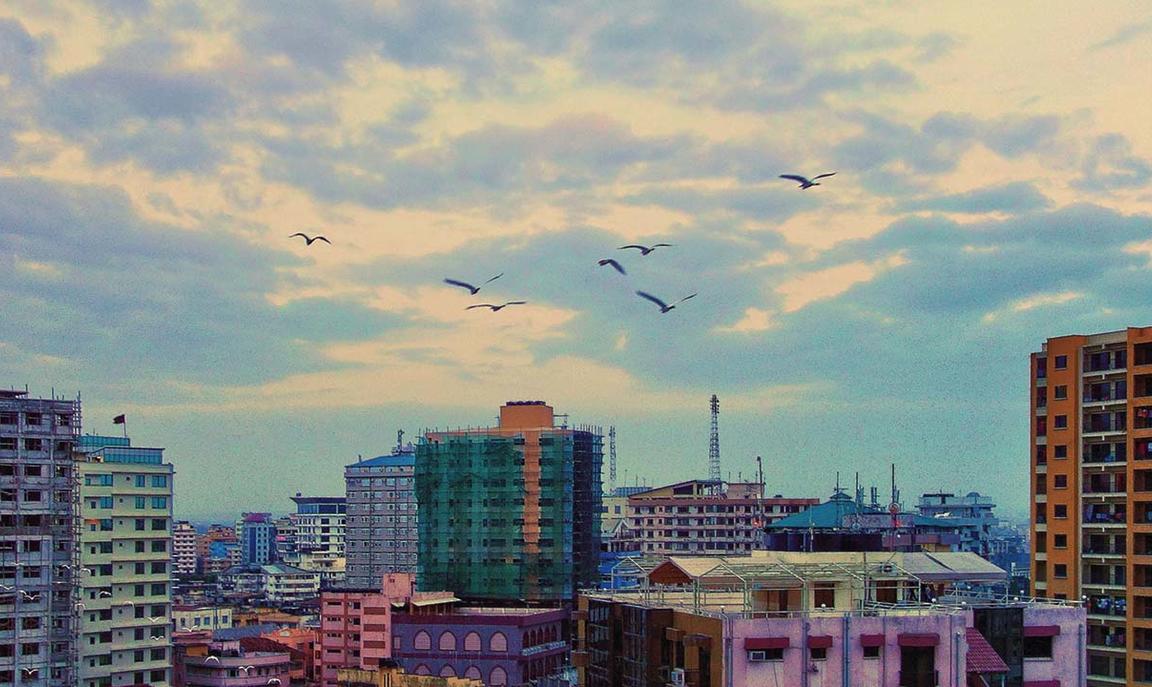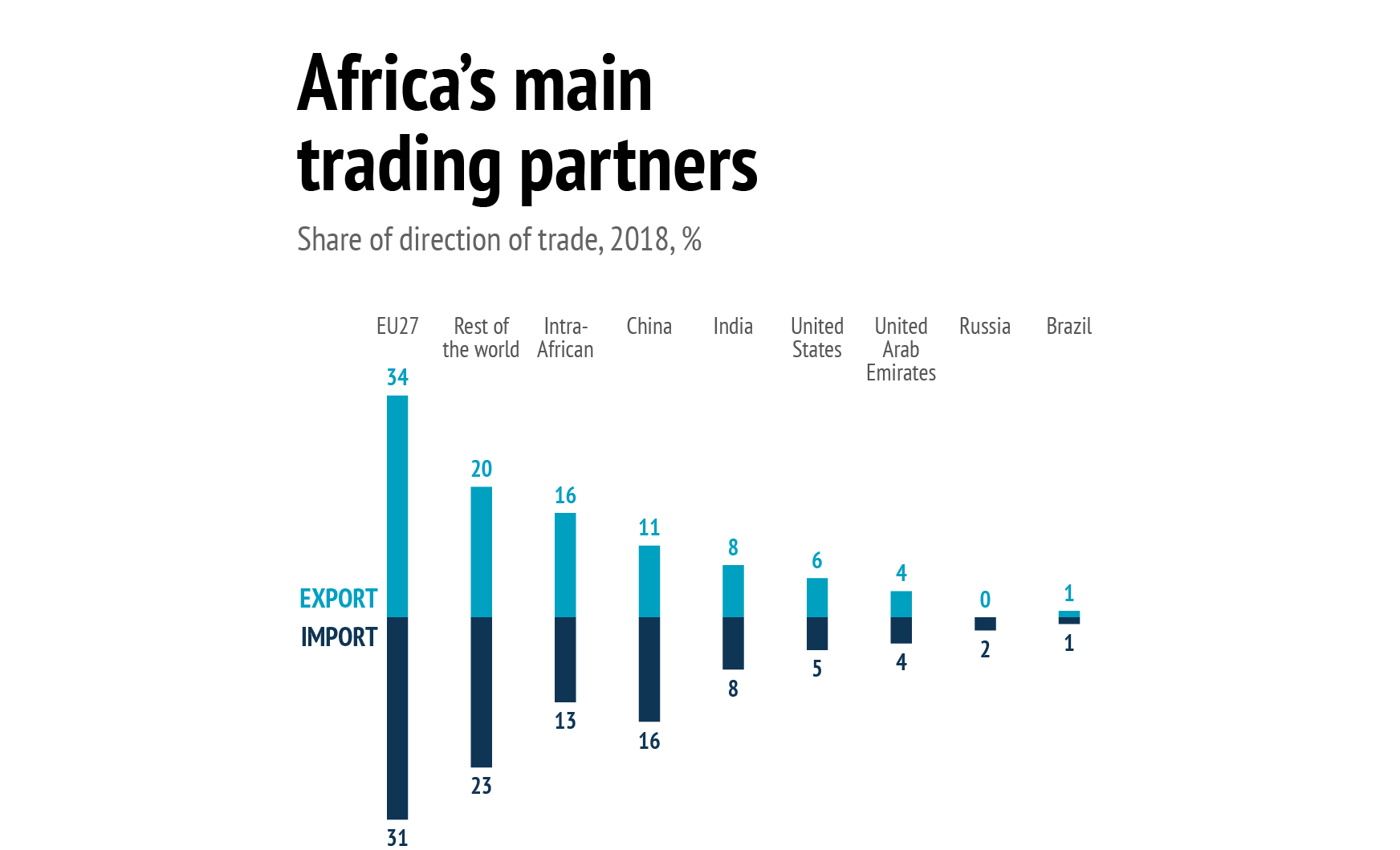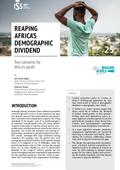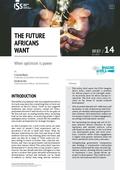You are here

What if Africa stops receiving foreign aid?
Introduction
The Covid-19 pandemic exacerbated poverty levels in Africa, with the number of people living in extreme poverty in sub-Saharan Africa projected to increase from 449 million (pre-Covid) to 478 million by 2022 (1). The crisis also induced the continent’s first economic recession in 25 years. Globally, the pandemic has generated multiple geostrategic uncertainties among nation states, and regional and international institutions. Policymakers in both donor and recipient countries are faced with the task of responding to the unpredictability of these developments, which may include reconsidering foreign policy priorities in the light of domestic imperatives. Addressing the possibility of declining investments and donor fatigue on the back of Covid-19, this Brief explores one key ‘if’ concerning the future of external support for Africa’s development: ‘what if, for the first time in more than 60 years, Africa stops receiving development assistance and foreign investments?’ The first section of the Brief describes a tipping point in 2030 showing Africa’s economic outlook in a future in which development aid and investments have been drastically reduced. The second section explains developments between 2021 and the tipping point in 2030, while the third section outlines the consequences in terms of Africa’s developmental aspirations. The last section offers suggestions to help Africa navigate future challenges.
Africa in 2030: The year zero in foreign aid
For the first time since the 1950s, Africa is faced with an unprecedented situation: the flows of official development assistance (ODA) and foreign direct investment (FDI) have contracted to historically low levels, in what the media have described as the ‘Year Zero of foreign aid’. This news is greeted with disbelief by many African leaders. Between 2011 and 2020, total FDI to Africa’s top 10 recipients stood at USD 300 billion (2), but in 2030 this figure contracted by 60 % with Egypt, Nigeria and South Africa recording the highest contractions. In a speech delivered to the 9th African Union-European Union (AU-EU) Summit in 2030, Mokgweetsi Masisi, the chairperson of the AU, urged the international community to reconsider its position on Africa, warning that ‘the world cannot expect to prosper when approximately one quarter of its population continues to live in extreme poverty.’ OECD data shows that the EU and its Member States were the largest donors to Africa, contributing approximately €20 billion per year in development aid (3).
In 2015, the EU-28 contributed 50.1 % of the total share of ODA to Africa and in 2018 EU aid to Africa increased by 4.3 %, totalling €25 billion. (4) In the same year, private investments by European firms amounted to €239 billion, accounting for nearly half of Africa’s overall FDI (5) compared to €15 billion (in aid) and €80 billion (investments) in 2030. Similarly, US and Chinese aid and investments to Africa contracted from a high of €30.9 billion and €13.9 billion in 2021 to €8.5 billion and €5 billion in 2030, respectively. Faced with a trade war with the US, and two pandemics in quick succession, China cut its budgetary support to African countries by over 20 %. A sudden drop in FDI and ODA set African governments into panic mode. An urgent AU-EU Summit in February 2030 to discuss the continent’s dire situation was cancelled at the last minute following major disagreements over the agenda of the meeting. In March 2031, the United Nations Economic Commission for Africa (ECA) published a report cautioning against the premature withdrawal of aid, warning that such a move risked reversing decades of development gains, specifically in the health, education, water and sanitation sectors.
The path to 2030
Data: European Parliament, 'A comprehensive EU strategy for Africa', 2019
Significant budget cuts in donor aid by the EU, United States and China were in part due to domestic political decisions taken to tackle the economic crisis induced by ‘long Covid’. Donors suddenly became more preoccupied with domestic imperatives and allocated less resources to traditional foreign policy instruments. While the humanitarian bill increased due to multiple overlapping crises, development aid envelopes were nearly emptied to respond to domestic priorities. The implementation of Africa’s economic transformation, including through the free trade area, slowed dramatically as a result. In 2026, the EU committed a paltry €10 million to support the rollout of the African Continental Free Trade Area (AfCFTA) compared to €74 million committed in 2021 (6). Collectively, the United States and China committed not more than €30 million – leaving a funding gap of €80 million. While sluggish implementation was to a large extent a result of significant donor budget cuts by some of Africa’s partners including the EU, other reasons included lack of political will among participating states, political instability and a protracted civil war in Ethiopia and post-election violence in Kenya following a highly disputed presidential election in 2027. These dynamics added new layers to the challenge of operationalising the continental free trade area and implementing policy reforms necessary for it to succeed. In South Africa, violent protests linked to inefficient service delivery in the lead-up to local government elections in 2026 forced neighbouring countries to shut their borders with one of Africa’s largest economies. Unable to trade with its neighbours, South Africa was isolated and key trade arteries connecting southern, east and central Africa blocked.
The number of authoritarian regimes rose across the continent, including in once promising democracies like Cabo Verde, Ghana, Mauritius and South Africa. These regressive developments prompted the European Commission in 2024 to suspend aid programmes to 20 countries, a historical record. Half of these did not meet conditionality criteria while the other half was too fragile to sustain any development projects. The World Freedom Press Index showed that a number of countries had further tightened and restricted media and press freedoms. As a result, Africa’s fragility index worsened in comparison to a decade earlier. Six more countries were placed in the ‘very high alert’ category, joining Somalia which had been classified as ‘very high alert’ since the collapse of Siad Barre’s government in 1991. Eight more countries, previously classified as ‘high warning’, now ranked in the ‘alert’ category. After years of hostility, Uganda went to war with Rwanda over a disputed border in the south.
Owing to protracted wars and internecine conflict in the Horn and the Sahel regions, important trade infrastructure such as roads, telecommunications and railway lines were destroyed by armed militia groups. The volatility and instability in the region created a wave of refugees and internally displaced people. Corrupt and criminal gangs linked to powerful transboundary militia groups in the Horn took over strategic seaports in Eritrea and Somaliland to facilitate the smuggling of goods and trafficking of persons to Europe and the Middle East. Around the same time, local human rights groups working in the Sahel petitioned the United Nations High Commissioner for Refugees (UNHCR) to put an end to human rights violations.
In addition to the contraction of ODA, worsening conflicts and instability scared off foreign investors and companies, causing a gradual decline in FDI. As a result, unemployment grew at an alarming rate. For instance, South Africa’s unemployment rate increased by 10 % between 2020 and 2030 while youth unemployment reached 50 % in Nigeria and Kenya. 90 million young Africans migrated to urban areas between 2020 and 2030, leading to a massive strain on infrastructure in some of Africa’s most populous cities including Mombasa, Kinshasa, Lagos and Abidjan.
Consequences of policy inaction
Economic stagnation worsened by donor budget cuts stalled Africa’s developmental progress and negatively impacted gains in areas such as health, education, poverty reduction and gender equality. With development partners unable to continue support for Africa’s green transition, about 100 million poor Africans were thrown into extreme poverty in the 2030s (7). Climate change wiped out at least 15 % of Africa’s GDP in 2034, significantly reversing gains achieved in the past 30 years §. ‘Unbalanced’ trade between Africa and the EU led to deindustrialisation and mass job losses. For instance, in 2018, EU-Africa trade was worth €235 billion – representing more than 30 % of Africa’s total trade (9). In the same period (see graph opposite) African exports to the EU constituted 34 % of total trade and African imports from the EU averaged 31 % (10). In 2030, African exports to the EU amount to just under €125 billion, with the bulk of the continent’s exports now destined for new markets in China, the United States and India. The new European Commission Joint Communication Strategy with Africa, which came into force in 2020 aiming to create strategic partnerships between the EU and Africa, faltered as new players like China, Russia and India moved in to fill the void created by the EU.
In 2029, another global pandemic struck, the second in under a decade, severely undermining recovery efforts. While African countries were relatively shielded from the disastrous health effects of this pandemic, the economic fall-out was massive, in part due to Africa’s indebtedness to China whose GDP contracted by over 10 %. Economic activity on the continent shrank by 4 % in 2029 (double the 2020 figure (11)) and recovery was projected to be extremely slow and difficult. Across the world, US-China trade wars resurfaced following a Republican victory in the 2024 US election. These trade wars negatively impacted the completion of key infrastructure projects funded by the Chinese government like the Grand Inga Hydropower Project in the Democratic Republic of Congo, a multibillion-dollar project scheduled to be completed in 2025, but which never saw the light.
By 2032, China became Africa’s biggest and largest trading partner thanks to China’s new ambitious plan for Africa backed by a financing package of USD 300 billion over a 4-year period. However, China’s influence in Africa induced a slide towards authoritarianism as more African countries assimilated China’s model of state-led economic growth under one-party, authoritarian rule. While China’s promise to create millions of jobs in Africa failed to materialise, African countries’ geopolitical pivot towards China was facilitated by the fact that several of them were already heavily indebted to China by 2024. For example, Zambia’s debt to China ballooned from USD 6.6 billion in 2021 to over USD 10 billion in 2030 (12).
The EU’s Carbon Border Adjustment Mechanism aiming to make the EU climate neutral by 2050 resulted in thousands of job losses in Africa, particularly in the agricultural sector since African products could no longer meet EU import standards. Faced with a bleak future back home and unable to secure employment, thousands of young Africans trekked Africa’s dangerous dirt roads towards the Mediterranean in search of employment and a better life in Europe. The International Organization for Migration (IOM) recorded a 25 % increase in the number of African migrants at Europe’s shores in 2035 from a ‘high’ of 15 % recorded between 2014 and 2016 (13). Climate change and environmental degradation contributed to new dynamics in migration patterns, generating new forms of instability and fragility. For instance, armed conflicts between pastoralists and farmers in East and West Africa became extremely violent. In Niger, militia groups armed with rudimentary weapons smuggled through porous borders attacked and killed 120 pastoralists in rural Agadama in April 2031. The conflict in Agadama created a refugee crisis in the region and while the international community increased humanitarian support for Africa, specifically for conflict migrants and refugees through the UNHCR, this type of support was unlikely to help Africa achieve its developmental aspirations expressed in Agenda 2063 (14).
A significant chunk of EU aid to Africa was oriented towards supporting the continent’s peace and security processes including the operationalisation of the African Peace and Security Architecture (APSA) and early warning detection and response initiatives. Since its inception in 2004, the Africa Peace Facility (APF) – the EU’s core peace and security programme for Africa – spent over €2.7 billion (15). Another equally important economic programme, the Pan-African Programme tasked with supporting key economic and trade projects, disbursed €845 million between 2014 and 2020 (16). Without this crucial support APSA failed to implement some of its core activities, while the prospects of Africa’s economic flagship project, the AfCFTA, prematurely failing sent shockwaves across the continent. The AfCFTA was touted by many analysts as a ‘solution’ to the continent’s enduring problems of ‘jobless growth’ and security challenges. The APF’s collapse left in its wake pockets of instability and insecurity across the continent.
Conclusion
This Brief seeks to alert decision-makers about potential developments with significant strategic impact while they can still prepare for or even avoid them, showing the need to keep investing in long-term, sustainable development and resilience, even when this runs counter to short-term priorities. More resources need to be directed to development in order to ensure that African states and economies recover from the Covid-19 pandemic. On the one hand, the scenarios show that EU aid and investments are, and will remain, critical to address urgent needs (such as supporting vulnerable health systems) and long-term ones (such as digital transformation and agriculture). On the other hand, the EU alone will not be able to bridge Africa’s financing gap. This highlights the need for an approach that brings together Africa’s major partners, including China and the United States, to work towards reinforced multilateral and cooperative solutions. It is the only way to scale up financial flows, boost reforms and promote a sustainable and inclusive growth path benefiting African countries.
References
1. Based on available data, 433 million Africans were estimated to live in extreme poverty in 2018, compared to 284 million in 1990. See World Bank, Data Blog, ‘The number of poor people continues to rise in Sub- Saharan Africa, despite a slow decline in the poverty rate’, 16 December 2020 (https://blogs.worldbank.org/opendata/number-poor-people- continues-rise-sub-saharan-africa-despite-slow-decline-poverty-rate) and ‘Updated estimates of the impact of Covid-19 on global poverty: turning the corner of the pandemic in 2021?’, 24 June 2021 (https://blogs. worldbank.org/opendata/updated-estimates-impact-covid-19-global- poverty-turning-corner-pandemic-2021).
2. ‘Here are the top ten African countries with highest FDI’, Business Insider – Africa, 4 June 2021 (https://africa.businessinsider.com/ local/markets/here-are-the-top-10-african-countries-with-highest- fdi/7264vlz).
3. European Parliament, DG for External Policies, ‘A Comprehensive EU Strategy for Africa: Trade and investments’, Briefing No 3, 2020. (https:// www.europarl.europa.eu/RegData/etudes/BRIE/2020/603509/EXPO_ BRI(2020)603509_EN.pdf).
4. Ibid., p. 6.
5. European Commission, ‘Team Europe mobilises to support African economies’, 18 May 2021 (https://ec.europa.eu/commission/presscorner/ detail/en/IP_21_2543).
6. United Nations Economic Commission for Africa, ‘EU pledges 74 million euro funding for AfCFTA’, 19 August 2021 (https://repository.uneca.org/ handle/10855/46618).
7. The World Bank, ‘Rapid, climate informed development needed to keep climate change from pushing more than 100 million people into poverty by 2030’, 8 November 2015 (https://www.worldbank.org/en/news/ feature/2015/11/08/rapid-climate-informed-development-needed-to- keep-climate-change-from-pushing-more-than-100-million-people- into-poverty-by-2030).
8. Ibid.
9. ‘A Comprehensive EU Strategy for Africa’, op.cit., p. 6.
10. Ibid.
11. The World Bank, ‘The World Bank in Africa’, 2021 (https://www. worldbank.org/en/region/afr/overview).
12. Brautigam, D., ‘How Zambia and China co-created a debt “tragedy of the commons”’, Working Paper No 51, September 2021, China Africa Research Initiative, School of Advanced International Studies, Johns Hopkins University, Washington, D.C. (http://www.sais-cari.org/publications-policy-briefs).
13. Global Migration Data Analysis Center, ‘African migration to Europe: how can adequate data help improve evidence-based policymaking and reduce possible misconceptions?’, Data Briefing series, No 11, November 2017 (https://publications.iom.int/system/files/pdf/gmdac_data_briefing_ series_issue_11.pdf).
14. African Union, ‘Our aspirations for the Africa we want’ (https://au.int/en/agenda2063/aspirations).
15. African Union, The Africa-EU Partnership, ‘EU unveils a new strategy for Africa’, 10 March 2020 (https://africa-eu-partnership.org/en/stay-informed/news/eu-unveils-new-strategy-africa).
16. African Union, The Africa-EU Partnership, ‘What is the African Peace Facility?’ (https://africa-eu-partnership.org/en/financial-support-partnership-programme/african-peace-facility).


